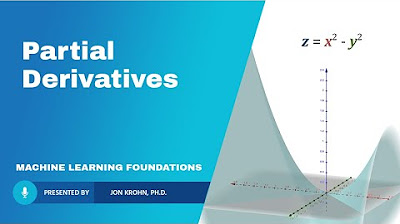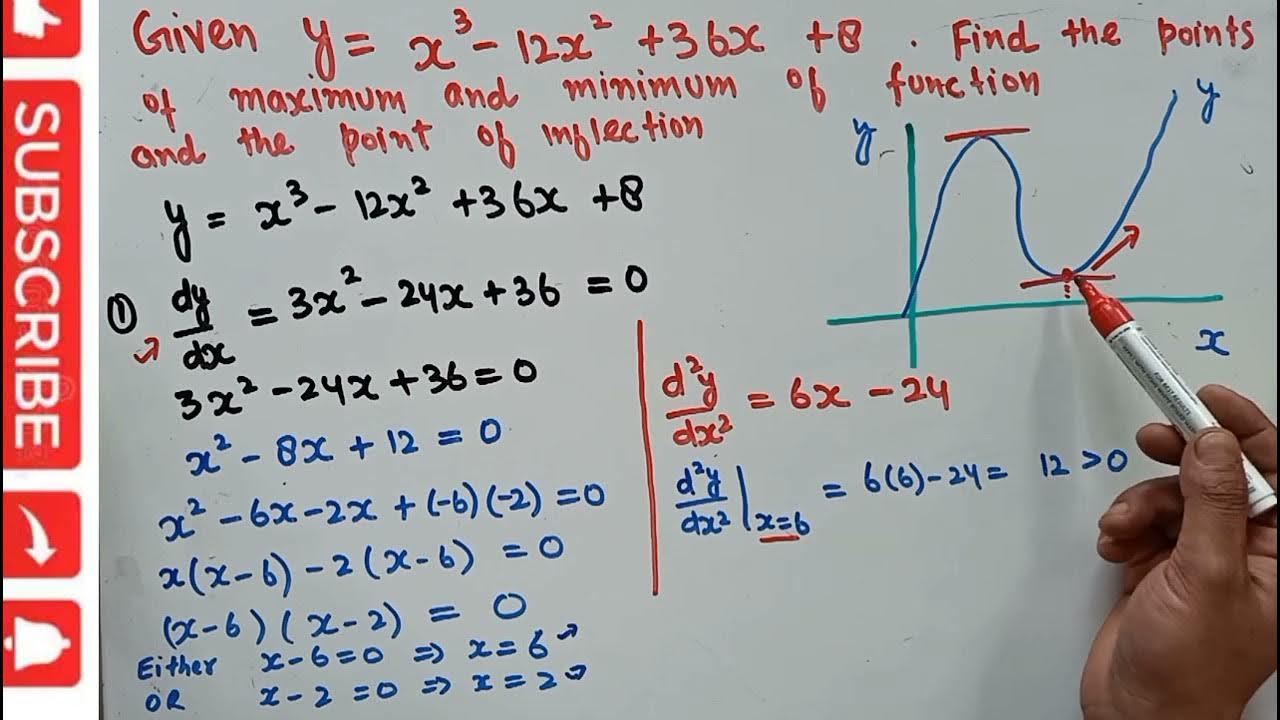Partial Derivative Exercises — Topic 68 of Machine Learning Foundations
TLDRThe video script focuses on exercises involving partial derivatives to enhance understanding of the concept. It presents three exercises where participants are tasked with calculating the value of 'z' and the slopes of 'z' with respect to 'x' and 'y' for given points using the function z = x^2 - y^2. The first exercise involves the point (3, 0), resulting in z = 9, a slope of 6 for x, and 0 for y. The second exercise uses the point (2, 3), yielding z = -5, a slope of 4 for x, and -6 for y. The third exercise calculates for the point (-2, -3), resulting in z = -5, a slope of -4 for x, and 6 for y. The video emphasizes the utility of manual calculation for grasping calculus principles but also highlights the efficiency of automatic differentiation, especially with numerous variables. The speaker also promotes a more detailed course on Udemy for further learning.
Takeaways
- 📚 The video provides exercises on partial derivatives to enhance understanding of the concept.
- 📝 Exercise one involves calculating the value of z and its slopes at a point where x=3 and y=0 using the function z = x^2 - y^2.
- 📈 At the specified point, the value of z is 9, the slope with respect to x (∂z/∂x) is 6, and the slope with respect to y (∂z/∂y) is 0.
- 📊 The video includes visual representation of the calculated point and slopes on a chart.
- 📝 Exercise two deals with a point where x=2 and y=3, resulting in z=-5, ∂z/∂x is 4, and ∂z/∂y is -6.
- 📝 Exercise three calculates the values for a point where x=-2 and y=-3, yielding z=-5, ∂z/∂x is -4, and ∂z/∂y is 6.
- 🤖 Automatic differentiation is mentioned as a tool that simplifies the process of finding partial derivatives, especially with many variables.
- 📹 The video suggests pausing to work through the exercises before revealing the solutions.
- 🔗 The presenter promotes a more detailed walkthrough available in a Udemy course named 'Machine Learning and Data Science Foundations'.
- 🧮 The importance of manually calculating partial derivatives is emphasized for a deeper understanding of calculus.
- 📝 The exercises are designed to be worked out with pencil and paper or any other available tool, encouraging active participation.
- 🔑 The script serves as a guide for those interested in strengthening their grasp of multivariate calculus and its applications.
Q & A
What is the function used throughout the notebook in the video?
-The function used is z = x^2 - y^2.
For the point where x equals three and y equals zero, what is the value of z?
-The value of z at that point is nine.
What is the slope of z with respect to x at the point (3, 0)?
-The slope of z with respect to x at that point is 6.
What is the slope of z with respect to y at the point (3, 0)?
-The slope of z with respect to y at that point is 0.
For exercise two, what are the values of x and y?
-In exercise two, x equals 2 and y equals 3.
What is the value of z at the point (2, 3) in exercise two?
-The value of z at that point is negative five.
What is the slope of z with respect to x at the point (2, 3)?
-The slope of z with respect to x at that point is 4.
What is the slope of z with respect to y at the point (2, 3)?
-The slope of z with respect to y at that point is negative 6.
For exercise three, what are the values of x and y?
-In exercise three, x equals negative two and y equals negative three.
What is the value of z at the point (-2, -3) in exercise three?
-The value of z at that point is negative five.
What is the slope of z with respect to x at the point (-2, -3)?
-The slope of z with respect to x at that point is negative four.
What is the slope of z with respect to y at the point (-2, -3)?
-The slope of z with respect to y at that point is six.
Why is it helpful to determine partial derivatives by hand?
-Determining partial derivatives by hand helps in understanding how calculus works in practice, especially for those learning the concept.
What is automatic differentiation and why is it useful?
-Automatic differentiation is a method that enables the quick and easy calculation of derivatives, which is particularly useful when dealing with a large number of variables.
What resource is mentioned for a more detailed walkthrough of the exercises?
-The video mentions a Udemy course called 'Machine Learning and Data Science Foundations' for a more detailed walkthrough.
Outlines
📚 Introduction to Partial Derivatives Exercises
The video begins by introducing exercises focused on partial derivatives, encouraging viewers to actively participate by solving numerical problems to enhance their understanding of the concept. The host presents three exercises, starting with calculating the value of 'z' and its slopes with respect to 'x' and 'y' for a given point (x=3, y=0) using the provided function z = x^2 - y^2. The video suggests using a pencil and paper or a whiteboard for these calculations and also mentions that the same exercise should be performed for two additional points.
Mindmap
Keywords
💡Partial Derivatives
💡Exercises
💡Function
💡Slope
💡Calculation
💡Comprehension
💡Multivariate Function
💡Chart
💡Automatic Differentiation
💡Machine Learning and Data Science Foundations
💡Udemy Course
Highlights
The video provides exercises on partial derivatives to enhance understanding of the concept.
Exercise one involves calculating the value of z and its slopes at a point where x=3 and y=0 using the function z = x^2 - y^2.
For the given point in exercise one, the calculated value of z is 9, with a slope of 6 for x and 0 for y.
The video includes visual representation of the calculated point on a chart.
Exercise two calculates the slope of z with respect to x and y at the point where x=2 and y=3, resulting in slopes of 4 and -6, respectively.
A new chart is created to visualize the additional point calculated in exercise two.
In exercise three, the point where x=-2 and y=-3 results in a z value of -5, with slopes of -4 for x and 6 for y.
The video emphasizes the importance of understanding how calculus works in practice through manual calculation of partial derivatives.
Automatic differentiation is introduced as a quicker and easier method for handling large numbers of variables.
The video mentions a Udney course for a more detailed walkthrough of the exercises.
The course is titled 'Machine Learning and Data Science Foundations'.
The exercises are designed to strengthen comprehension through hands-on calculation.
The use of pencil and paper or a whiteboard is suggested for working through the exercises.
The video covers three distinct exercises to practice calculating partial derivatives.
The function used throughout the notebook is z = x^2 - y^2.
The video provides solutions to the exercises, enhancing the learning experience.
The concept of a multivariate function is introduced in the context of the exercises.
The video encourages pausing to work through the exercises before revealing the solutions.
The practical applications of calculus in machine learning and data science are alluded to.
The video concludes with a teaser for the next video, which will tackle automatic differentiation.
Transcripts
Browse More Related Video

Calculating Partial Derivatives with PyTorch AutoDiff — Topic 69 of Machine Learning Foundations

Implicit Differentiation With Partial Derivatives Using The Implicit Function Theorem | Calculus 3

Partial Derivatives

What Partial Derivatives Are (Hands-on Introduction) — Topic 67 of Machine Learning Foundations

Maxima , minima and point of inflection

How To Find The Equation of a Secant Line
5.0 / 5 (0 votes)
Thanks for rating: